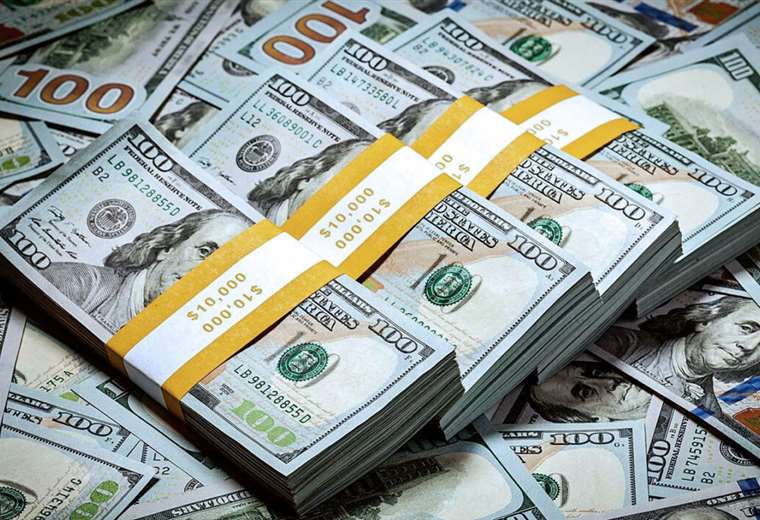August 26, 2022, 4:00 AM
August 26, 2022, 4:00 AM
Until the end of this year, the Bolivian State will pay $us 1,265 million for the capital, interest and commissions of its external debt, 53% more compared to 2021, when $826 million were disbursed for the same concepts, reported the Central Bank of Bolivia (BCB).
Of the total to pay, “US$1,021 million (80.7%) corresponds to capital and US$243 million (19.2%) to interest and commissions. In this regard, it is necessary to clarify that, for the projected service corresponding to the debt securities, $500 million correspond to the payment of the Bolivian Sovereign Bond 22”, indicates the External Public Debt Report as of December 31, 2021, published eight months after the completion of that administration.
Analysts agree that the Movement Towards Socialism (MAS) gave effect to its policy of international indebtedness of Bolivia in 2007, after the cancellation carried out by other countries and financial multilaterals. The acquisition of credits continued in the boom season for raw materials and accelerated in recent years, given the lower income received and to reduce the fiscal deficit that has been dragging on since 2014.
According to BCB data, external debt maintained a stable upward trend from 2008 ($2,505 million) to 2016 (7,267 million), but it began to accelerate from 2017 (9,428 million) to reach $12,589 million as of July 2021.
However, that last figure only increased to $12,697 million as of December 2021, after in May of this management the issuing entity approved a resolution through which excludes from accounting for the country’s external debt the allocations and deposits made by the IMF, IDB, IBRD, IDA, Fonplata and MIGA.
Rene Martinez, analyst of public budgets of the Jubilee Foundation, maintained that, “if this change in the accounting record had not been made, the growth of the foreign debt It would have been approximately US$600 million”, that is, it would have reached almost US$13.3 billion.
Through a press release, the Ministry of Economy observed that, “although it is important to monitor the value of Bolivia’s foreign debt over time, it is What really matters is to know the percentage that this debt represents with respect to GDP, which is a more appropriate metric to assess debt sustainability.”
In this context, he indicated that that figure is equivalent to 31.2% of GDP, “a percentage that would remain among the lowest in history.”
“Although the level of debt is below the thresholds of indebtedness, is growing very quickly, which gives us some signs of risk of unsustainability in the future”, warned the Jubileo researcher.
“For nine years, the Government has spent much more than it receives in taxes and has shown enormous difficulties in dealing with projects of investment or expenditure (of the State). So, by not having their own and genuine resources, they resort to increasing the external debt”, asserted the economist Gonzalo Chávez.
“The origin of the indebtedness is the public deficit made up of public investment and excessive and superfluous expenses, as in the case of YPFB, in which there is a union political class that in some cases earns more than Bs 40,000 without working. It is the State subsidizing the politicians”, he limited.
According to the BCB, as a result of the revitalization of public investment promoted by the productive community social economic model, In 2021, the country received $US 1,366 million as a disbursement from multilateral, bilateral and private organizations.
Data from the Ministry of Development Planning show that From 2006 to April of this year, almost US$12,994 million were disbursed in credits for the State. In 2021, the amount was US$1,366 million, the third highest in the 15 years of the MAS government, surpassed only by those registered in 2017 (1,395 million) and 2019 (1,520 million).
The BCB report realizes that 36% of the debt was allocated to road infrastructure, 12.4% to multi-sector projects, 8.1% to health, 6.7% to basic sanitation, 6.1% to institutional strengthening and 30.7% to agricultural programs, energy, mining, communications, structural adjustment, education, hydrocarbons, tourism and others.
“There should be an audit of the external debt, to find out more fully what these resources have been used for. It is known that a large part of the debt is sovereign bonds that, according to the regulations with which they were issued, should be for budgetary support, freely available in a certain way, ”said Martínez.
“In the register of the debt hThere are very large amounts that are in (the categories) Other Sectors and Several that should be known what they have been used for, “he said.
The Ministry of Economy maintained that in Bolivia The allocation of resources from international indebtedness to public investment is “prioritised”“with the aim of increasing the country’s productive capacity, which in turn facilitates the generation of income to pay the debt in the medium and long term.”
“Although in the year 2021 and the current administration, the General Treasury of the Nation (TGN) prioritized resources to deal with Covid-19, the impact was direct on the welfare and health care of the Bolivian population. For example, the fatality rate in the first wave was greater than 6%, in contrast to the rates of the fourth and fifth waves, which were less than 1%”, he specified.
“Therefore, the budgetary effort in these efforts was worth it, not only to take care of the population’s health, but also because it allowed establishing the necessary conditions to progressively return to normality in economic activities, which generated a context of greater certainty for the economy”, indicated the ministry in its press release.
Before the modification to the accounting record of foreign debt, the World Bank projected that in 2022 Bolivia’s total consolidated public debt will have “a value close to 80%”, a debt that includes that of the central government, subnational governments, public companies, foreign and private national creditors, the public financial sector and the BCB.
This value is above the regional average (69.8%), but it is not the highest in Latin America and the Caribbean, he specified. In its report, the agency considers that, since the end of the boom in commodity prices in 2014, Bolivia has experienced a significant increase in debt thanks to external financing and the BCB.
“This financing has helped maintain a relatively high growth rate and has financed much of the emergency spending resulting from the pandemic. We believe that countries, and Bolivia is no exception, could explore new ways to boost growth without continually increasing public debt”, William Maloney, the Office of the World Bank Chief Economist for Latin America and the Caribbean, informed EL DEBER. .


















